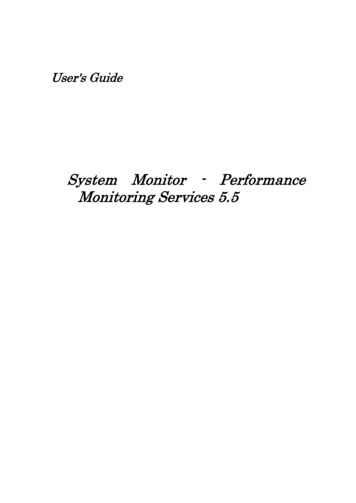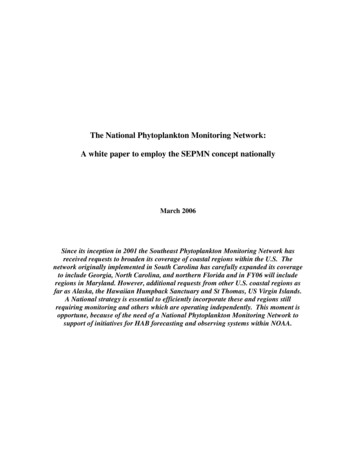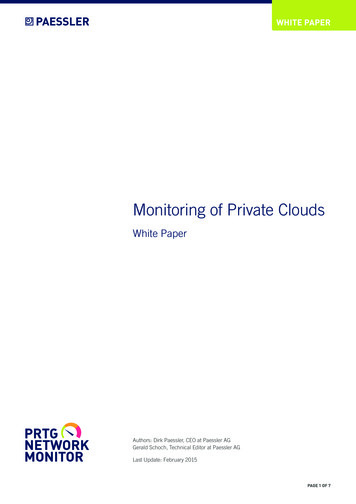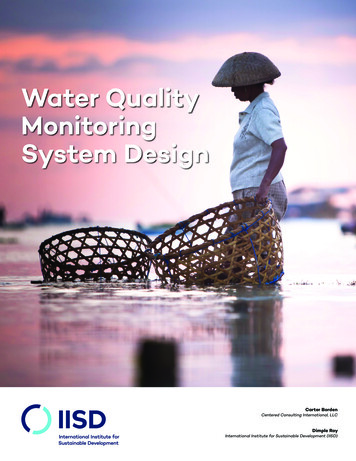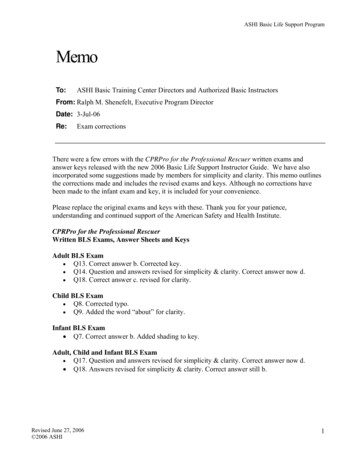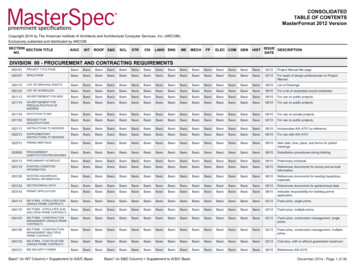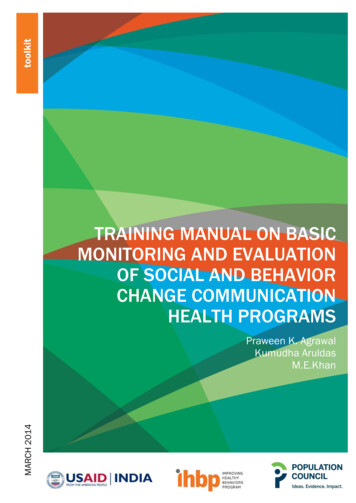
Transcription
toolkitTRAINING MANUAL ON BASICMONITORING AND EVALUATIONOF SOCIAL AND BEHAVIORCHANGE COMMUNICATIONHEALTH PROGRAMSMARCH 2014Praween K. AgrawalKumudha AruldasM.E.Khan
The Population Council confronts critical health and development issues—from stopping thespread of HIV to improving reproductive health and ensuring that young people lead full andproductive lives. Through biomedical, social science, and public health research in 50countries, we work with our partners to deliver solutions that lead to more effective policies,programs, and technologies that improve lives around the world. Established in 1952 andheadquartered in New York, the Council is a nongovernmental, nonprofit organization governedby an international board of trustees.Population CouncilZone 5A, Ground Floor, India Habitat CenterLodi Road, New Delhi 110 003IndiaTel: 91-11-24642901/02www.popcouncil.orgSuggested citation: Agrawal, P.K., K. Aruldas & M.E Khan,. 2014. Training Manual on Basic Monitoringand Evaluation of Social and Behavior Change Communication Health Programs. New Delhi: PopulationCouncil.
Table of ContentsList of abbreviations . .04Introduction . . .05Module 1: Basics of social and behavior change communication. . .07Module 2: Introduction to monitoring and evaluation . . 15Module 3: Developing logical framework analysis for a SBCC program . . 22Module 4: Monitoring of SBCC program at district and block level . .27Module 5: Research designs for evaluating SBCC program . .39Module 6: Role of qualitative methods in evaluating SBCC program . .49Module 7: Developing terms of reference for evaluating SBCC program . .61Glossary: . .70
List of Tables and FiguresTables3.1 Example of log frame for SBCC . 244.1 Location hunt form . 284.2 Checklist for quality assessment of group meeting conducted by CHW . 294.3 Exit Interview form . 304.4 SBCC activity report . 32Figures1.1 Health Belief Model . 081.2 Socio- Ecological model for change . 091.3 Theory of reasoned action/planned behavior . 101.4 Three key strategies of social behavior change communication . 12iii
List of AbbreviationsASHAAccredited Social Health ActivistBCCBehavior Change CommunicationFHI 360Family Health InternationalFPFamily PlanningIECInformation, Education, and CommunicationIHBPImproving Healthy Behaviors ProgramIPCInterpersonal CommunicationIUCDIntra-uterine Contraceptive DeviceM&EMonitoring and EvaluationNGONon-governmental organizationNIHFWNational Institute of Health and Family WelfareNRHMNational Rural Health MissionSBCCSocial and Behavior Change CommunicationSHRCState Health Resource CenterSIHFWState Institute of Health and Family WelfareTORTerms of referenceTVTelevisionUSAIDUnited States Agency for International Developmentiv
IntroductionSocial and behavior change communication (SBCC) interventions are increasingly seen as the keyinterventions for addressing social and cultural barriers and achieving goals laid out for healthprograms. States have the responsibility to plan and implement SBCC activities. Focus on mass media,community mobilization and interpersonal communication is increasingly gaining importance as SBCCinterventions in the State Project Implementation Plans (PIPs) with increasing resource allocation toachieve the objectives. Often these interventions are not evidence based and especially for mass mediait is mistakenly assumed that the interventions will benefit all equally. Though monitoring andevaluation (M&E) of overall National Rural Health Mission (NRHM) is considered important, M&E ofSBCC interventions is limited. Lack of trained and skilled human resources for M&E has been alimitation in general. This demands a serious effort to build capacity of M&E personnel to monitor andevaluate performance of SBCC interventions in terms of reach and effectiveness among intendedaudiences.Improving Healthy Behaviors Program (IHBP) of FHI360, funded by USAID, aims to provide technicalassistance to strengthen capacities to monitor and evaluate SBCC intervention for maternal health,family planning, tuberculosis and HIV/AIDS at of public program managers at national, state and districtlevel. The project is coordinating with National Institute of Health and Family Welfare (NIHFW), and theState Institute of Health and Family Welfare (SIHFW) to build the trainers capabilities within the state inthis area. The Population Council will train a cadre of master trainers on M&E of SBCC activities at thenational and state level who would further build capacity of human resources responsible for M&E ofSBCC activities within the state at the district level.To address the capacity building initiative in M&E of SBCC intervention, a 'Training Manual on BasicMonitoring and Evaluation of Social and Behavior Change Communication Health Programs' is prepared.The key personnel trained in this initiative will include master trainers, state program M&E officers andmanagers, district level officials and supervisors whose main job is to monitor SBCC interventions intheir geographical area of work. The extent of involvement of these personnel in planning and executingthe M&E activities vary. Therefore, the depth of training content covered will vary depending on the levelof function of the officials and supervisors that are trained.The training manual is comprehensive to include various aspects of M&E. It includes the following sevenmodules:Module 1: Basics of SBCC: The learning objective of module-1 is to differentiate between IEC andSBCC; orient participants on how theories of behavior change have evolved and the process used indesigning a SBCC intervention.Module 2: Introduction to monitoring and evaluation: The module-2 will enable participants to learnwhat is monitoring and evaluation and distinguishes between process, output and outcome indicatorsspecific to social and behavior change.Module 3: Developing logical framework analysis for a SBCC program: From module-3, the participantswill learn to develop a logical framework matrix that will guide M&E of SBCC interventions. They will alsolearn to develop indicators with respective to the goal, objectives and activities of the SBCC program.Module 4: Monitoring of SBCC program at district and block level: Using module-4, the participant willunderstand how to monitoring quality of SBCC activities implemented and design district and block1
specific feedback mechanisms.Module 5: Research designs for evaluating SBCC program: The objective of module-5 is to orient theparticipants to various evaluation approaches and frameworks, increase capacity to design appropriateevaluation methodology and orient to overcoming barriers in effective evaluation.Module 6: Role of qualitative methods in evaluating SBCC program: The objective of module-6 is toorient participants on importance of qualitative approaches for monitoring and evaluation of SBCCinterventions. They will learn about various qualitative methods.Module 7: Developing terms of reference for evaluating SBCC program: The module-7 is mainly meantfor the state officials who will learn how to develop Terms of Reference for contracting agencies forevaluation of SBCC programs.Overall, the training manual is organized around concepts of M&E for SBCC interventions with st rengthsand weakness of approaches and recommendations wherever applicable and necessary. The manualaims to strengthen efforts of SBCC interventions by building capacity to effectively monitor and evaluateintervention against desired outcomes and provide learning for SBCC strategies. The guiding principlesin development of this manual are the various roles played by officials at various levels within the state;the block supervisors are responsible for supervising implementation of day to day activities andproviding feedback during weekly and monthly meetings; district M&E officers are responsible for datacollation to assess the progress of interventions using output indicators and provide feedback and thestate level officials in addition to monitoring are also responsible for evaluation of the programs. Thetraining methodology and the possible exercises that could be used to facilitate learning are mentionedin the ―Facilitator‘s Guide‖ that accompanies this manual.2
Module 1BASICS OF SOCIAL AND BEHAVIOR CHANGE COMMUNICATIONLearning Objectives To know the difference between Information Education and Communication and Social andBehavior Change Communication To have an overview of various theories of behavior change To understand the Socio-Ecological model for changeWhat is the difference between IEC and SBCC?Information, Education and Communication (IEC) is a process of providing information and education toindividuals and communities to promote healthy behaviors that are appropriate to their context. It isbelieved that having correct knowledge will lead to adoption of healthy behaviors but the experience ofIEC programs shows that knowledge is not a necessary and sufficient condition for behavior change.There are lot of examples which show that giving correct knowledge has not always led to adoption ofhealthy behaviors. This is because adoption of a behavior is also influenced by the external environment;the local context, family and community at large, in which the individual is placed.Social and Behavior Change Communication (SBCC) has evolved from earlier models of IEC and is anevidence-based, consultative process of addressing knowledge, attitudes, and practices throughidentifying, analyzing, and segmenting audiences and participants in programs and by providing themwith relevant information and motivation through well-defined strategies, using an appropriate mix ofinterpersonal, group and mass media channels, including participatory methods (Neill McKee, 2002).SBCC aims to affect changes in knowledge, attitudes, and practices and is a more comprehensiveapproach than IEC. SBCC involves analyzing personal, societal, and environmental factors forsustainable change and uses strategies that influence the physical, socio-economic, and culturalenvironment to facilitate healthy norms and choices and remove barriers to them.3
Theories of behavior changeHealth Belief ModelThe Health Belief Model is a psychological model of behavior change. It is based on the individuals‘perception of acquiring the disease and its severity ; analysis of benefits in taking action to reduce thebarriers in adopting healthy behavior and relative cost benefit of adopting a healthy behaviour (Figure 1).FIGURE 1.1: THE HEALTH BELIEF MODELModifying factorAgeGenderIndividual's perceived: susceptibility severity threatChange inbehaviorKnowledgeSocio-economicstatusPrevious experiencePrevious experienceIndividual's perceived: benefit of changingbehaviorSource: Adapted from Stretcher, V., & Rosenstock, I.M. (1997). The Health Belief Model. In Glanz K., Lewis, F.M., & Rimer BV. K.,(Eds). Health Behavior and health Education: Theory, Research and Practice. San Francisco: Jossey -Bass.4
Theory of Reasoned Action/Planned BehaviorThe Theory of Reasoned Action, modified as Theory of Planned Behavior, is a socio -cultural model forbehavior change. In this, the primary determinant of behavior is the individual‘s intention to perform itwhich depends on their attitude towards performing the behavior and the individual‘s perception of thesocial (or normative) pressure exerted upon them to adopt or not to adopt the behavior (Figure 2).FIGURE 1.2: THE THEORY OF PLANNED BEHAVIORIndividualAttitude towardsthe behaviorChange inSocietal normsbehaviorPerceived notionaboutacceptability ofthe behavior bythe societyIntention tochangebehaviorIndividualPerceived ability tochange thebehaviorSource: Adapted from Ajzen, I. (1991). The theory of planned behavior. Organizational Behavior and Human DecisionProcesses, 50, p. 179-211.Socio-Ecological Model for ChangeSocio-Ecological Model for Change SBCC applies a socio-ecological model that examines several levelsof influence to provide insight on the causes of problems and find tipping points for change. A tippingpoint refers to the dynamics of social change, where trends rapidly evolve into permanent changes. Itcan be driven by a naturally occurring event or a strong determinant for change—such as political willthat provides the final push to ―tip over‖ barriers to change. Tipping points describe how momentumbuilds up to a point where change gains strength. It has two parts (Figure 3):1.Behaviors are influenced by personal and environmental factors and multiple levels ofinfluence, which include: Individual (the person or ‗self‘ in relation to the program)5
Interpersonal (partners, family members, peers) Community (leaders, health workers, media, policy-makers)The immediate people of influence are husband and other family members and peers (second ring infigure 3). Their interactions with the individuals influence the behavior of the individuals. Both theinterpersonal and community rings shape community and gender norms, access to and demand forcommunity resources, and existing services. The people represented in the outer two rings communitylevel influencers including health care providers, community leaders and influencers, and others outsideof the community like government officials, NGOs, and private providers. They exert influence throughpolicies and legislation, political forces, private sector market environment, economic conditions,religion, technology, and the natural environment.FIGURE 1.3: THE SOCIO-ECOLOGICAL MODEL FOR CHANGE2.Behaviors are also influenced by a number of cross-cutting factors such as: Information (knowledge, education) Motivation and attitudes Ability to act (access, efficacy) NormsCross-cutting factors (in the triangle) influence each of the actors and structures in the rings. The cross cutting factors are information, motivation, ability to act and norms. It is on these cross -cutting factorsthat SBCC interventions may be able to generate change. People need information that is timely,6
accessible and relevant. For example, if information about modern contraceptives and their side effectsis given some individuals or couples will be empowered to act. Motivation is determined by attitudes,beliefs or perceptions about benefit and risks. For example, some women may believe that intra-uterinecontraceptive device (IUCD) will move up to the heart. Such individuals could be motivated by effectivecounseling with demonstration models, peer education, and even radio and TV programs. However, forsome women motivation may not be enough to accept IUCD and they need self-efficacy to decide skillsto negotiate, and avail IUCD services (access ability to act). Further, individuals may be governed byperceived norms which are followed by others individuals and socio-cultural norms that the communityfollows. So the same is expected from him or her. There are gender norms which shape the behaviors ofmen and women.What SBCC can and cannot do?SBCC CanSBCC CannotInformation Increase knowledge and awareness of an issue,problem, or solutionCounter myths and misconceptionsMotivation Influence perceptions, beliefs, and attitudes that maychange social normsShow the benefit of behavior changePrompt actionTrigger an individual to adopt and maintain a newhealth behaviorAbility to Act Demonstrate and provide an opportunity to practiceskillsReinforce self- and collective-efficacyStrengthen organizational and network relationshipsAddress barriers/systemic problems, such asinsufficient access to care through advocacy andmobilizationNorms Change Support or initiate norm changeMobilize community members or whole socialmovementsAdvocate for a health or development issue or policyInitiate adoption of a new policy directionHow does SBCC work?SBCC is a process that involves: Understanding the situation Focusing and designing the strategy Creating interventions and materials Implementing and monitoring Evaluating and re-planning7 Compensate for inadequateinfrastructure or logistics of services,lacking access to them or policiesregulating themIt can, however, mobilize or advocate foran improvement in these areas.Produce sustainable change without thesupport of other program components orwhole programs providing services,technology, and enforcing regulationsand policiesIt can, however, link with these programsand make their work visible.Be equally effective in addressing issuesin different countries with cookie-cutterstrategiesIt can, however, provide how-to tools andguidelines for adaptation and tailoringtoward specific audiences and theirexisting assets or barriers to change.
SBCC operates through three key strategies (Figure 4). These include:1. Advocacy – to raise resources as well as political and social leadership commitment to developactions and goals2. Social mobilization – for wider participation, coalition building, and ownership, includingcommunity mobilization3. Behavior change communication (BCC) using mass and social media, community-level activitiesand interpersonal communication (IPC) for changes in knowledge, attitudes, and practicesamong specific audiences.FIGURE 1.4: STRATEGIES OF SOCIO-ECOLOGICAL MODEL FOR CHANGEWhat is a Social and Behavior Change Communication Strategy?The SBCC strategy is a framework indicating direction and scope of communication activities. Thedevelopment of SBCC strategies should be based on SBCC theory, research and available evidences thatwill identify the barriers and the facilitating factors for each of circles mentioned in Figure 4. The SBCCstrategy forms the road map for "WHAT do you want to get WHERE?" and should focus on followingelements:Analysis SummaryoProblem statementoResearch needsoChanges the problem involvedCommunication StrategyoTarget audiences8
oDesired changes, barriers, facilitators, communication objectives by audienceoStrategic approachoPositioningoKey contentoCommunication channels (e.g. mass media, mid-media, IPC), activities, and materialsTen Principles of SBCCPrinciple 1: Follow a systematic approach (e.g., C-Planning).Principle 2: Use research, not assumptions to drive your program.Principle 3: Consider the social context.Principle 4: Keep the focus on your audience(s).Principle 5: Use theories and models to guide decisions (e.g., the socio-ecological model).Principle 6: Involve partners and communities throughout.Principle 7: Set realistic communication objectives and consider cost-effectiveness.Principle 8: Use mutually reinforcing materials and activities at many levels.Principle 9: Choose strategies that are motivational and action-oriented.Principle 10: Ensure quality at every step.Thus, SBCC is the systematic application of interactive, theory and research-driven communicationprocesses and strategies that address change at individual, community, and societal levels.In summary, SBCC Has evolved from IEC and BCC and employs a more comprehensive approach. Refers to both social change and behavior change. Is the systematic application of interactive, theory and research-driven communicationprocesses and strategies that address change at individual, community, and societallevels. is a process, uses a socio-ecological model, and operates through three key strategies Advocacy, Social mobilization and BCC9
REFERENCES1. Bandura, A., C. Pastorelli, C. Barbaranelli, and G.V. Caprara. 1999. Self-Efficacy Path-ways toChildhood Depression. Journal of Personal and Social Psychology, 76:2, pp. 258-269.2. Janz, N.K., and M.H. Becker. 1984. The Health Belief Model: A Decade Later. Health EducationQuarterly, 11:1 (Review), pp.1-47.3. Ajzen, I. (1991). The theory of planned behavior. Organizational Behavior and Human DecisionProcesses, 50, p. 179-211.4. Kelly, J. 1995. Changing HIV Risk Behavior: Practical Strategies. The Guilford Press, New York.5. McKee, N., Manoncourt, E., Chin, S.Y. and Carnegie, R. (eds.). 2000. Involving People, EvolvingBehavior. New York: UNICEF, Penang, Malaysia:Southbound.6. Rosenstock, I. M., V.J. Strecher, and M.H. Becker. 1988. Social Learning Theory and the HealthBelief Model. Health Education Quarterly, 15, pp. 175-183.10
Module 2INTRODUCTION TO MONITORING AND EVALUATIONLearning Objectives What is monitoring and evaluation and they differ? What is indicator? What are different types of indicators? Characteristics of a good indicator2.1 WHAT IS MONITORING AND EVALUATION?MonitoringMonitoring is systematic and purposeful observation and timely data collection to check if programactivities are being implemented as planned in terms of frequency, timing, and sequence, if applicable.More precisely, monitoring tracks and measures program activities to answer what activities are done,where, with whom, when and how many.Monitoring is used to track changes in program performance over time against measurable indicatorsdefined well in advance. Its purpose is to permit stakeholders to make informed decisions regarding theimplementation and performance of programs and the efficient use of resources. Monitoring is doneinternally often by program managers themselves or concerned program monitoring staff. Monitoringhelps in establishing controls to make sure that implementation is on track and moving towardsachieving the objectives of the program. Therefore, it is a continuous day-to-day management process ofchecking, analyzing and giving feedback into program activity and resource allocation plans.Monitoring of SBCC programs involve routine data collection, both quantitative and qualitativemeasurements, and analysis to check process and outputs to provide timely answers like: are the communication activities being implemented as planned? is the quality of implementation good? are the materials, channel and equipment used to communicate messages culturally acceptableand effectiveIn summary, monitoring for SBCC program: is a continuous process of data collection and analysis at multiple points throughoutthe program cycle, including a baseline at the beginning is used to determine if activities are implemented as planned helps in taking decision on midterm correction based on evidences, if required; alerts and guides utilization of planned resources and timely execution requires data collection tools and quality assessment checklists11
EvaluationThe evaluation is a systematic process that attempts to determine objectively relevance, effectiveness,and impact of activities in relation to the objectives intended to achieve. It measures how well theprogram activities have met expected objectives and/or the extent to which changes in outcomes can beattributed to the program or intervention. The evaluation also provides insights into the future of theprograms, for both implementers and donors, in terms of sustainability, scalability and policy implication.Therefore, evaluation differs from monitoring in terms of timing and focus and level of details ofoutcome of the program.Evaluations can be conducted during the project period or at the end of the project period depending onthe purpose of the evaluation. Evaluation, unlike monitoring, involves data collection at discrete pointsin time e.g. baseline, midline and endline surveys. Evaluation requires a comparison of measureablechanges in the level/prevalence of the outcome variables before and after the SBCC interventions. Inevaluation of SBCC interventions, it measures to answer: whether the SBCC intervention has achieved its objective of adoption of desired behaviors andor outcome indicators identified in the program? extent equity and gender has been address in the campaign and with what effects? extent the changes could be sustained , economically viable and could be scaled up beside these key measures of SBCC effect, evaluation also could throw light on those issueswhich have /could have direct bearing of the outcomes or impact Whether barriers to social and behavior change is reduced by SBCC interventions? the reach of SBCC program specially among intended audience in the long term, the extent of diffusion effects that helped adoption of the behavior in largercommunity the role played by the predictors of facilitating factors to behaviour changeIn summary, evaluations of SBCC programs: requires a well-planned evaluation study design and data collection tool require data collection at the start of a program (to provide a baseline) and again at theend to assess the extent the proposed program outcomes or impact of the SBCCinterventions have been achieved it gives insight into causal factors and implication to change in future determine the quality of the program2.2 WHAT IS INDICATOR?Indicators are measurements used in monitoring and evaluating program performance. Indicators areprogram specific and are defined by the objectives of the program. Indicators can use both onquantitative and qualitative measurements. Indicators should be measurable and helps to assess theextent the SBCC intervention has changed the outcomes.The process of selecting indicators can be fairly easy if objectives are presented clearly in terms of12
defined quantity, quality, and timeframe of a particular program activity. Ideally, during the planningprocess of the program, the indicators must be defined and linked to the activities and objectives.It is important to understand and differentiate program indicators and communication indicators.Program indicators refer to the outcome of a program to achieve the goal such as change incontraceptive use, reduction in unmet need. However, communication indicators measures thecommunications provided through different channels such as IPC, mid-media or mass media to reducemyths or misconceptions and increase correct knowledge. It also includes process indicators like reachof the given messages, comprehension of the messages etc.Types of IndicatorsMonitoring Indicator: There are two types of monitoring indicators- process andoutput.Process indicators: Process indicators helps in assessing how the planned activities have beenimplemented both with respect to time schedule and quality of the implementation. Example could be:percentage of ASHAs passing competency based training for improved counseling and services, TVadvertisement tested and adjusted to cultural context, messages given are clear and understood by thetarget audience, characters present in the entertainment education are perceived from their owncommunity, etc.Output indicators: Output indicators provide measures the extent the planned activities have beenactually implemented. It is must that these monitoring indicators are fixed prior to the implementation.In SBCC, outputs are the direct products of the campaign and measured in terms of campaign activitiesperformed. Examples could be: number of street show organized, number of wall painting done, numberof TV spots with messages aired, number of group meetings organized, and number of ASHA trained incounseling skills and provided with counseling aids, etc. It is important to note that outputs do notmeasure any outcome indicators like behavior change or increase in knowledge of the audience.Evaluation indicators: There are also two types of evaluation indicator- outcome and impact.Outcome indicators: Outcome indicators measure the outcomes that the SBCC program hopes toachieve, and identified in the communication objectives. Outcomes indicators are intermediate results ofthe impact which is the ultimate objective of the program. Examples could be: percentage ofcontraceptive uses, percentage initiated early breastfeeding, percentage availed postpartum care fornewborn and mother, percentage adoption of skin to skin care, percentage delayed first bath of newbornetc.Impacts indicators: Impacts indicators measure the long-term effects, or end results, of a SBCC program.It takes longer span of time to achieve. This may not necessarily captured in evaluation of a shortduration campaign. The example of the impact indicators are; change in birth rate, change in HIVincidence rate, and change in neonatal and infant mortality.A systematic framework provides link between inputs, process, outputs, outcomes and impact indicatorsof a project goal. A visual presentation of these indicators in case of family planning program can beseen in figure 1.13
Immediate ChangesLong – termChangesIncreased service utilizationContraceptivesClinic ling,ClinicsessionsorganizedIncreased providers knowledgeIncrease in hand washingReduction inCBR/TFRIncreased use of ORS zincDecrease indiarrhoeal deathReduction in unmet needsDecreased in MMRIncrease in contraceptive useSource: adopted from Williams, K. and Ramarao, S. 2009Appropriate M&E questions on the objectives of SBCC intervention and work plan can be helpful indeveloping ap
The training manual is comprehensive to include various aspects of M&E. It includes the following seven modules: Module 1: Basics of SBCC: The learning objective of module-1 is to differentiate between IEC and SBCC; orient participants on how theories of behavior change have evolved and the process used in



